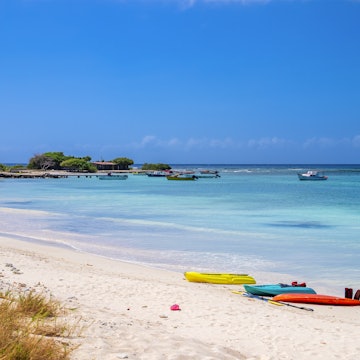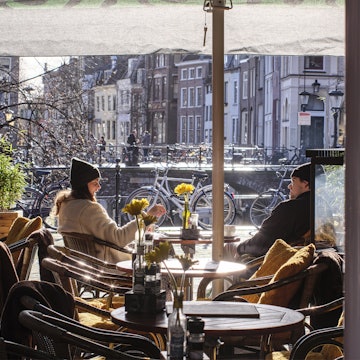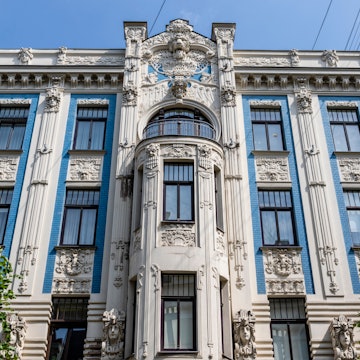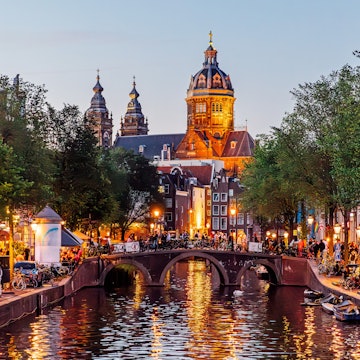

Cycling is perhaps the essential mode of transport in Amsterdam. Wolf-photography/Shutterstock
Charming, compact and famously flat, Amsterdam is exceptionally easy to explore. Centered on its UNESCO-listed grachtengordel (canal ring), the city’s core is entirely walkable, and its surrounding neighborhoods and countryside beyond are laced with cycle paths that make it perfect for discovering by fiets (bicycle).
The Dutch capital also has a superbly organized public transport network that encompasses trams, buses and metros, as well as free ferries. Here’s what you need to know to get around Amsterdam.

Zip into the city from Schiphol Airport
One of Europe’s major global hubs, Amsterdam’s Schiphol Airport is just 11 miles (18km) southwest of the center, linked by trains, buses and taxis.
Trains operated by national rail company NS are the quickest and cheapest way to reach the center. From Schiphol’s station beneath the terminal (platform 3), frequent services include up to eight trains an hour (fewer at night) that make the 17-minute trip to Amsterdam’s Centraal Station.
Tickets and travel cards are sold in the terminal, or you can use contactless payment (known as OVpay), checking in and out with your credit or debit card (Maestro, V PAY, Mastercard or Visa), or “smart wallet” phone app.
Bus stops B1 to B20 are located immediately outside the arrivals hall on Koepelstraat. Connexxion’s Amsterdam Airport Express (bus 397 or Niteliner N97) departs every 10 minutes (hourly at night) from stop B17; it’s a handy direct option for places near Museumplein and Leidseplein. Many hotels have complimentary airport shuttle buses.
Late at night, when trains and buses are less frequent (and road traffic is lightest), a taxi may be more convenient. It takes around 25 to 40 minutes to the city center and costs from €45 to €55 ($50 to $61). A ride-hailing service may work out cheaper; meet drivers at app pick-up points E1 to E6 further northwest on Koepelstraat.
Explore central Amsterdam on foot
Walking around the city center lets you chance upon tiny lanes, cozy bruin cafés (traditional pubs), restaurants and shops you might otherwise miss.
Navigating the historic central canal ring, it helps to remember that the major canals all run in a horseshoe-shaped loop, in alphabetical order. (The only exception is the Singel Canal, once a fortification line, which forms the innermost ring.)
Familiarizing yourself with the locations of the main squares Dam (some 800m south of Centraal Station), Leidseplein and Rembrandtplein will also keep you on track.
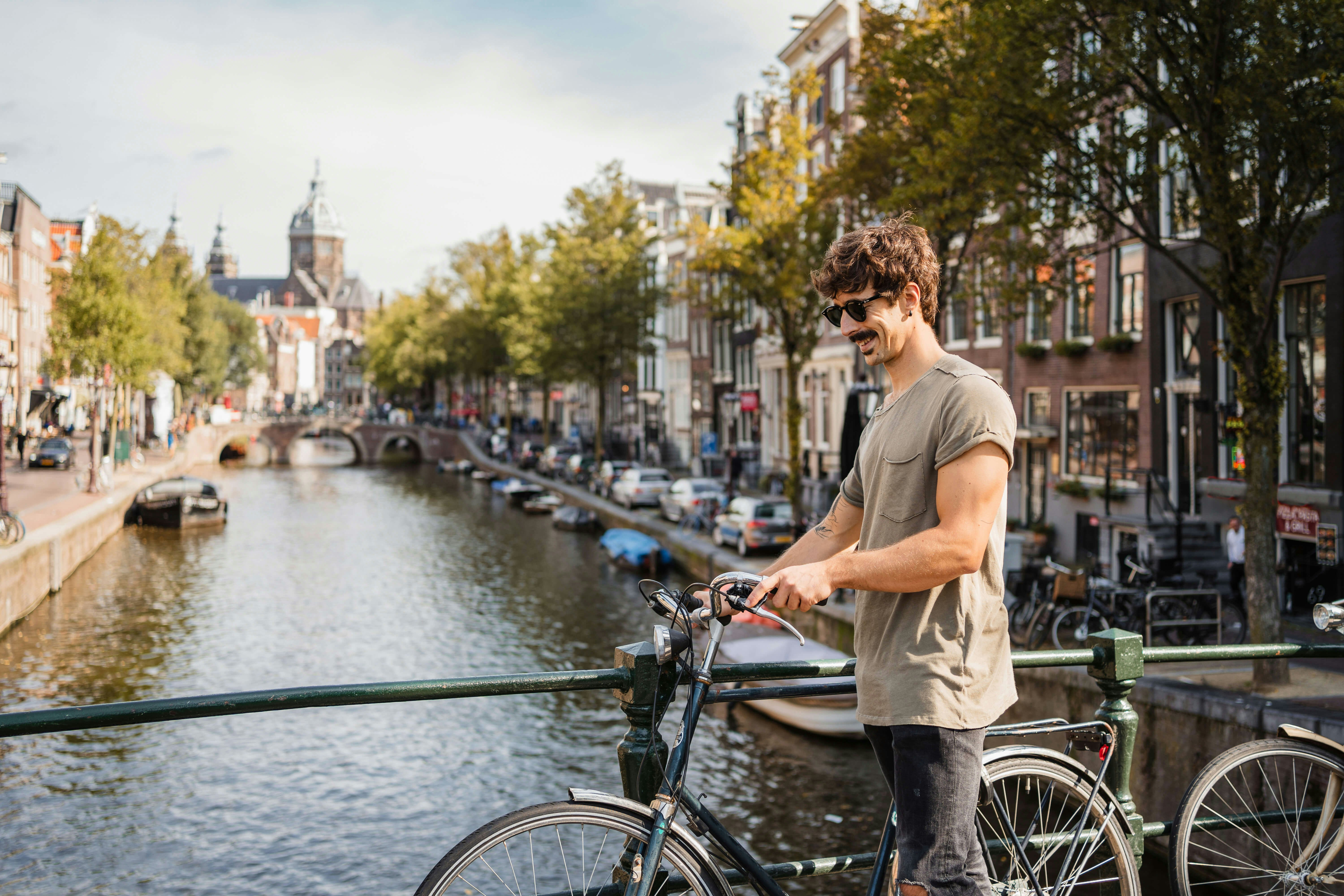
Do as the Dutch do and hop on a bike
Cycling is the most beloved mode of transport in the Netherlands and – outside of the inner city’s smallest and/or busiest thoroughfares – Amsterdam is no exception. Pedaling offers a relaxing and sustainable way to access parks and open spaces in less-touristy neighborhoods, and take in the city from a wonderful, moving perspective.
You’ll find bike-hire shops everywhere; a day’s rental starts at around €15 ($17). Choosing a rental company without bike branding will help you blend in. Take care to ride in the red-asphalt bike lanes, not on the footpaths for pedestrians.
Planning tip: Bike thieves in Amsterdam know how to get creative, so consider purchasing theft insurance. Alternatively, bike-renting apps with pay-per-minute plans – like Donkey Republic – are good for short distances. Note that standing e-scooters (locally known as a “step”) are banned in Amsterdam.
Master local transport
Amsterdam’s public transport is run by GVB. Its excellent app incorporates journey planner 9292.nl, which calculates your most efficient journey options city- and countrywide, and provides live transport updates including crowd estimates.
Most public transport within the city is on its distinctive blue-and-white trams. Many of the 15 lines converge on Amsterdam Centraal Station.
In areas with fewer trams, the gaps are filled by buses (all will be electric by 2030). Amsterdam also has five metro lines extending to the outer suburbs. They’re mostly used by commuters; line M52 handily runs from Amsterdam Noord via Centraal Station, Dam Sq, the Southern Canal Ring and De Pijp on its way south.
If you don’t have a travel card (see details below), using OVpay you can simply check in and out with your contactless debit or credit card or phone (charged per km plus a fixed base rate, and billed as a single transaction at the end of each day; no prior registration needed). You’ll need to use the same card/payment method to both check in and out.
Local tip: Amsterdam’s trams, buses and metros stop running around midnight, at which point the city’s network of 11 night buses takes over. Taxis are slow to get around and are usually only available at stands and in busy areas; most locals prefer ride-hailing services.

Escape the tourist crowds on a ferry
Free ferries departing from the waterfront behind Centraal Station and crossing the IJ river are a great way to explore lesser-visited, up-and-coming neighborhoods. During rush hours, you’ll share the deck with locals breathing in the fresh air, bicycles and mopeds in tow.
The main ferry connection to Buiksloterweg (line F3; most popular for sightseeing in Amsterdam Noord) runs frequently during the day and more sporadically at night.

Skip driving in Amsterdam
Driving in central Amsterdam is not recommended due to its maze of narrow streets often blocked by unloading trucks, with unfenced canals, abundant bicycle lanes and tram tracks (80% of inner-city streets have a speed limit of 30 kph, around 18 mph). Add to that scant parking, which is also astronomically expensive and rarely available at accommodations. Check the city of Amsterdam’s website for low-emission vehicle requirements within the A10 ring road and P+R (park and ride) locations.
If you do decide to drive, be mindful that all streets in the central canal ring are one-way, and to drive on the right. When approaching intersections, some canal bridges might not have traffic signs. Watch out for pedestrians and bikes everywhere.
Accessible transportation in Amsterdam
Travelers with reduced mobility will find Amsterdam moderately equipped to meet their needs.
Most canal cruises, buses and metro stations are wheelchair accessible. Some trams have wide-opening doors and leveled platforms; those that don’t will not be easy for those in wheelchairs. Check the GVB website for wheelchair-friendly stops, use the GVB journey planner’s accessibility option, or configure virtual stop assistance in the app. On board, all trams have designated space for wheelchairs and priority seating.
Accessible Travel Netherlands and the Able Amsterdam are excellent resources for further information.
Transport passes
If you’ll be taking public transport often, the right travel card can save you a bundle.
An Amsterdam Travel Card is a paper chip card that allows unlimited transport including to and from Schiphol Airport; it’s sold at ticket machines and information points at the airport. The Amsterdam & Region Travel Ticket version includes day trip destinations (such as Haarlem) in the surrounding area.
GVB has day tickets and multiday ticket options (up to seven days), available as paper chip tickets or as barcode tickets within the GVB app.
To combine sightseeing and transport, Amsterdam’s tourist pass, the I amsterdam City Card, includes GVB trams, metros, buses and ferries (but not transport to/from Schiphol Airport), 24 hours’ bike rental and a canal cruise, along with admission to over 70 museums and attractions (notable exceptions include the Anne Frank Huis and Van Gogh Museum). Durations range from one to five days. You can buy a digital card on the website, or a physical card at the I amsterdam store at Amsterdam Centraal Station.
Planning tip: Remember to check in on each ride by tapping your card to the reader, and tap again on exiting to check out. Your card will be valid after checking in on your first journey.








